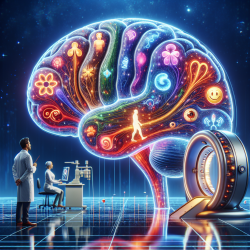For practitioners working with patients experiencing sensorineural hearing loss (SNHL), understanding the underlying neural changes can significantly enhance therapeutic approaches. A recent study titled Dissociation between Cerebellar and Cerebral Neural Activities in Humans with Long-Term Bilateral Sensorineural Hearing Loss provides valuable insights into how long-term SNHL affects brain function.
The Study at a Glance
The research explored how long-term bilateral sensorineural hearing loss impacts cerebellar function and its connectivity with cerebral regions. Using resting-state functional MRI (fMRI), the study examined 21 subjects with SNHL compared to 21 controls with normal hearing. Key findings highlighted decreased functional connectivity (FC) between the cerebellum and various cerebral areas, including the temporal pole, insula, and inferior frontal gyrus.
Implications for Practitioners
The study's findings suggest that SNHL disrupts cerebellar-cerebral circuits, which may be linked to emotional conditions such as anxiety. For practitioners, these insights offer several avenues to enhance patient care:
- Targeted Therapy: Understanding the disrupted connectivity can help tailor therapies that focus on improving cerebellar-cerebral interactions, potentially alleviating emotional symptoms associated with SNHL.
- Cognitive and Emotional Assessment: Regular cognitive and emotional assessments could be integrated into treatment plans to monitor changes in patients' conditions over time.
- Multi-Disciplinary Approach: Collaborating with neurologists or psychologists could provide a more comprehensive treatment plan addressing both auditory and emotional aspects of SNHL.
Encouraging Further Research
This study opens several avenues for further research that could refine therapeutic interventions for SNHL patients:
- Longitudinal Studies: More extensive longitudinal studies could help track changes in cerebellar-cerebral connectivity over time, providing deeper insights into the progression of SNHL-related brain changes.
- Diverse Patient Populations: Exploring these neural changes across diverse populations could reveal variations in how different demographic groups are affected by SNHL.
- Advanced Imaging Techniques: Utilizing advanced imaging techniques like graph theory-based network analysis might uncover more intricate details of brain connectivity alterations due to SNHL.
Conclusion
The disruption of cerebellar-cerebral circuits in SNHL patients presents both challenges and opportunities for practitioners. By integrating these research findings into practice, therapists can better address the complex needs of their patients. Moreover, continued research in this area promises to enhance our understanding of SNHL's impact on brain function, ultimately leading to improved therapeutic strategies.
To read the original research paper, please follow this link: Dissociation between Cerebellar and Cerebral Neural Activities in Humans with Long-Term Bilateral Sensorineural Hearing Loss.










